David Meerman Scott's Blog, page 74
May 8, 2013
How to Pitch a Blogger
I get several hundred pitches a week from well-meaning PR people.
Conversations with other bloggers suggest this is the norm, so now it is as tough to reach a blogger as it is to reach a mainstream journalist. It may be even more difficult since most of us work part-time on our blogs and we devote less time to wading though pitches as journalists.
Sadly, nearly all of the pitches I get are just plain spam.
But the good news is that I do pay attention to things that people send me. I occasionally write about them. So how do you increase your chances of getting a blogger like me to talk about you or your clients? Here are some ideas:
Don't pitch your product.
This is by far the worst thing to do. I may be interested in how people solve problems by using your product or service. But I don’t care about the product itself.
Keep in mind most bloggers have other ways to talk you up.
Don't limit your pitch to only the person's blog. Share what you think the person will be interested in, but realize you may be rewarded in a different way. In my case, I might tweet it. Or maybe it is a story is worth adding to a book I'm working on or as a riff in a speech. Don't limit yourself.
Remember, we're not journalists.
Bloggers write about whatever we feel like and we aren't obligated to "tell both sides of a story" or "cover your news." The best blogs are written by people who are passionate about a topic. Read the blog, discover the passion, and send something that the blogger will be interested in.
Don't offer guest posts unless the blogger runs them.
In nearly a decade of writing my blog, I've never run a post by a guest author. While I'm not prepared to say I never will, offering to write one for me is a sure way to have your email deleted. Make sure a blog runs guest posts before you pitch that as an idea.
Broadcast pitches are spam.
I love hearing about something interesting before others. If you've got a great example of marketing success, tell me! But don’t send me something that you also send to hundreds of others.
Never open with "Dear Blogger".
Dear Blogger tells people that you don't care enough about them to read their blog and learn their name. It's much better if you personalize your pitch with an appropriate greeting and some detail about why they were selected.
Make it short.
I won't read a long email. A few sentences about what you're pitching and why is great. If I want more information, I'll ask for it.
Never send an email attachment.
Links are okay but attachments are not.
Take care with the subject line.
Make your subject line specific. Something like "Example of newsjacking success" is a great subject line for me.
Twitter is good. Telephone is not.
It's fine to send a pitch via Twitter Direct Message or to include a blogger's Twitter ID in a tweet. The 140-character limit forces you to get to the point. But bloggers I've spoken with do not appreciate phone calls.
I've had many discussions with bloggers in recent years and most of us do like to get a well-crafted pitch targeted especially to us. We want you to reach out! Do it well, and we may write about you.
May 2, 2013
How Gareth Fairhurst used content marketing to get elected
 Gareth Fairhurst, a local councillor on Wigan Council, has used online communications and social media, including his blog, Twitter @cllrgwfairhurst, and Facebook to communicate with his constituents in Standish, a village in Greater Manchester, England.
Gareth Fairhurst, a local councillor on Wigan Council, has used online communications and social media, including his blog, Twitter @cllrgwfairhurst, and Facebook to communicate with his constituents in Standish, a village in Greater Manchester, England.
In 2012 Gareth, an independent, won re-election with twice the number of votes as his nearest major party rival. He credits his content marketing efforts as instrumental in his success.
"In the last local elections [May, 2012] I knew I had to try the online experience, as I was an independent candidate and that is always a disadvantage to the mainstream parties," Gareth told me. "There was a particular issue that people where concerned with so I used the blog as a starting point to set up an online petition. This allowed people to share the issue with their friends, which in turned associated my name with the campaign. It also helped me get 1000 peoples' email addresses over the election campaign."
While Gareth has been blogging since 2009, he recently changed his strategy. "I update my blog once a week on Sunday with what had been happening each week," he says. "Then I update my Twitter and Facebook account during the week with snippets," pointing people from the social networks to his blog. "This has seen an increase in my blog by over 60%."
While his rivals from The Labour Party and The Conservative Party used traditional leaflet drops during the 2012 campaign campaign, Gareth focused his efforts on social media and web content combined with personal meetings with constituents. "Here is the link to the result, which I believe demonstrates not only a massive win but you have to use new tools to connect with voters," he says.
Nice work Gareth! Keep going.
April 29, 2013
World's worst website
I'd like to nominate the English-language edition of the Tokyo 2020 Candidate City website as the worst English-language site in the world. The site is built in support of bringing the 2020 Summer Olympic Games to Tokyo.
Where to start. Well anywhere, really. So let's look at content.
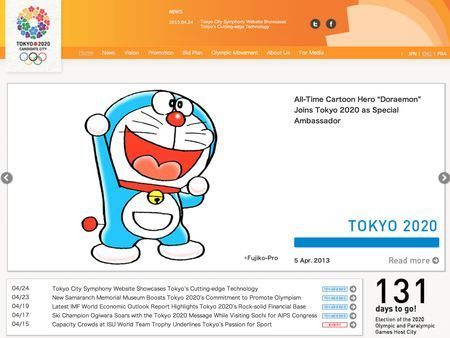 How about Vision:
How about Vision:
"Tokyo 2020 will bring together dynamic innovation and global inspiration. It will unite the power of the Games with the unique values of the Japanese people and the excitement of a city that sets global trends. It will be a unique celebration that will help reinforce and renew the Olympic Values for the new generation. And will contribute to more young people, worldwide, sharing the dreams, hopes and benefits of sport."
Huh? WTF?
This is about as gobbledygook as any paragraph I have ever read. And I've read a lot of bad ones over the years. We've got weasel words like the number one most over-used phrase in English language marketing: "innovation". Then there’s "global inspiration," "unique values" plus other world-class, cutting-edge, mission-critical nonsense. These phrases are so overused to have become meaningless.
A fun test of superlative-laden content like this is to substitute a competitor. So how about substituting into the paragraph above for Istanbul 2020 with the words "Istanbul / Turkish" or Madrid 2020 with "Madrid / Spanish." If the paragraph still makes sense with the competitor city substituted, then vision has failed.
Buyer personas... Or not.
While I could poke at additional content aspects of this terrible site that make it stink so much, I'll stop. Because what it really comes down to is the typical mistake of not understanding buyers.
I lived in Japan for seven years and my wife is Japanese. What we've seen so often is Japanese organizations that enter the global markets by simply translating the content they created for the local Japan marketplace. That's likely what happened here.
And it's too bad, really. Because Tokyo would make an excellent host city. But I fear the candidacy is doomed because of this rotten site.
For an example of missing the buyer persona, consider the use of animated characters that are so big in Japanese marketing. The people who made this site assumed that everyone in the world is attracted to anime so they carried it over to English too: All-Time Cartoon Hero Doraemon Joins Tokyo 2020 as Special Ambassador. Well not everyone is into the same stuff as the average eleven-year-old.
Who should be the buyer persona for this site? I'd argue the 115 voting members of the International Olympic Committee who choose the location of the 2020 games are the most important buyer persona. I'd have a tough time believing that this site reaches those people effectively.
When your organization goes global
While it is easy to sneer at this site and other crap-filled sites like it, imagine what happens when *you* simply translate *your* materials into the local languages of countries whose markets you enter. It is likely a similar thing happens to your site in the eyes of the local market if you translate your content.
To really globalize, you need local content creators who understand the local buyer personas and create content especially for them.
Voting for the Olympic host city takes place on September 7, 2013, as I write this a little more than 4 months away. There is still time to fix this site and increase Tokyo's chances.
April 25, 2013
Communications revolution
I'd like to step way, way back and look at the big picture of where we are today with our ongoing communications revolution.
This is not a view, to use the cliché, from 30,000 feet. It's the view from 1,000 years into the future.
The new rules of marketing and public relations are a part of the much bigger and incredibly important communications revolution we're currently living through—the most important in human history.
In my thinking there are three major periods in human communications:
The pre-printing-press era from the beginning of humanity through the mid-1400s
In this period, knowledge is very, very expensive because it needs to be either memorized or written by hand. Most of humanity is illiterate and life is difficult for most.
The era of printed information
Beginning 550 years ago, knowledge became cheap because it could be reproduced in such a way that most anybody could have access to their own books or those owned by others nearby. However, communications was only one way, from a relatively small number of knowledge creators to a large number of readers.
The era of web and mobile communications
In the past 18 years, information has become essentially free and two-way. The big picture ramifications are huge. One thousand years from now, the only two things that will be remembered in the history of the time period we are living right now will be the first lunar landing of Apollo 11 on July 20, 1969 and the development of real-time communications instantly connecting every human on earth with every other human on earth.
The second most important communications revolution in human history
Johannes Gutenberg's invention of printing with mechanical movable type (circa 1439) was the second most important communications breakthrough in history. It meant books could be mass-produced, rather than painstakingly copied by hand. It meant ordinary people could refer to things in books, like laws. These used to have to be committed to memory.
The printing press created the first communications revolution by freeing people's minds from memorization and allowing them to use that extra brainpower to be creative. At the same time, this first communications revolution (which took many decades) helped large numbers of people become literate and raised living standards along the way.
No longer relying on religious leaders for the truth
The invention of the printing press meant that average people could learn to read and understand knowledge for themselves. This meant that they had a choice to no longer rely on religions leaders for the truth. People could decide on their own that, say, the earth really did revolve around the sun.
The printing press brought changes to humanity that lifted Europe out of the medieval period and into the Renaissance.
However, this communications method is essentially one way – from publishers of information to consumers of information.
The single most important communication revolution in human history
Some 556 years later, in 1995, the most important communications revolution began. I choose 1995 because it was the year that Netscape went public on the success of Netscape Navigator, the first popular product to allow easy Internet connection and web browsing.
We're fortunate to be living in this time in history, the time of another important communications revolution. I figure we’re about halfway through it. The first nearly twenty years or so were fast-paced, and things changed very quickly. Usage went from a few million people online to billions.
Now any person with an internet or mobile phone connection can communicate in real time with virtually any other human on the planet. Talk about a revolution.
Mobile phone adoption
According to the International Telecommunications Union, there were 5.9 billion mobile phone subscriptions worldwide in 2011, and mobile networks are available to more than 90 percent of the world’s population. It's not just creaky old technology either; some 150 countries offer high-speed 3G service.
In fact, more people have access to mobile phones than have access to toothbrushes. More people have access to mobile phones than have access to working toilets.
No longer relying on companies and government leaders for the truth
When people can communicate in real-time with one another, it has fundamental ramifications for humanity.
A handful of people in Egypt can create a Facebook group that generates support from millions of ordinary citizens and brings down a government.
Anybody can do independent research on the web and choose what to believe about the products and services they consume.
The revolution drives the economy
 Mobile phone technology has far reaching influence on the world's economy. People who relied on traditional selling techniques in use for hundreds or even thousands of years suddenly have a global market at their fingertips.
Mobile phone technology has far reaching influence on the world's economy. People who relied on traditional selling techniques in use for hundreds or even thousands of years suddenly have a global market at their fingertips.
I saw this firsthand when I was visited the village of Cangandi in the Guna district of Panama last year on an expedition organized by my friends at Earth Train.
What’s remarkable about Cangandi is that the several hundred villagers chose to move the entire village over one kilometer away to the top of a hill because that was the one place that had good mobile phone reception. In 2010, they moved the entire village - huts and all - obviously a massive undertaking.
The village of Cangandi does not have running water. It does not have electricity. But does have cell reception (with solar power for recharging).
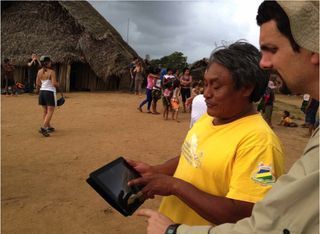 This has transformed the way they do business. Previously, before they had mobile devices, they would load up their canoes with the products they grow such as cassava roots, maize, and plantains and paddle downriver to the Pacific Ocean to the islands there to see who needed to buy. But it was hit or miss. If another seller had been there recently there was no way to make a sale, so they frequently returned after several days wasted.
This has transformed the way they do business. Previously, before they had mobile devices, they would load up their canoes with the products they grow such as cassava roots, maize, and plantains and paddle downriver to the Pacific Ocean to the islands there to see who needed to buy. But it was hit or miss. If another seller had been there recently there was no way to make a sale, so they frequently returned after several days wasted.
Now, they have spot market intelligence. Islanders frequently contact them to place orders which the villagers deliver when needed and at a fair price. This is particularly relevant for cassava and other roots because the plants can be kept alive for a long time and harvested as needed or when the offered price and desired quantity make sense.
Without that communication learning of spot market opportunities via mobile devices villagers would frequently be stuck with a canoe full of roots out at sea skipping from island to island only to find that there is little need for roots right then and that they have to sell at a loss.
What about you?
Even now, nearly 20 years into the revolution, many organizations still aren't communicating in real-time on the web.
Are you one of the revolutionaries? Or do you support the old regime? Are you marketing your product or service like the villagers of Cangandi? Or are you failing to produce content on the web that will do well in the search engines and social networks?
The next few decades will bring a continuation of the revolution. We need to be constantly learning and updating our skills to reach buyers as they're looking for the products and services we sell.
This is an exciting time to be in marketing and communications. In 1,000 years, people will study this period in history books to learn about the tremendous transformations in society brought by the changes that we are living today.
Just like we study the transformation from medieval times leading to the Renaissance due to the knowledge gained from the printing press, the wide availability of mobile technologies and web content to the entire world means humanity is made better.
Images: 1) Villagers in Cangandi, Guna Yala, Panama. 2) Former Secretary General of the Guna General Congress (and Earth Train board member) Enrique "Kike" Arias while in Cangandi.
April 21, 2013
The HubSpot Culture Code: Creating a Company We Love
My friends over at HubSpot published a deck on Slideshare called The HubSpot Culture Code: Creating a Company We Love.
The presentation deck started out as an internal document years ago (it doubles as the company handbook). As a company who values transparency (and inbound marketing), they decided to share it with the community as a manifesto.
As I write this, it has generated a remarkable 384,000 views in just one month!
Culture Code: Creating A Lovable Company from HubSpot All-in-one Marketing Software
I have seen the HubSpot culture up close since I joined the company's advisory board in 2007. It is an absolute joy to walk into their ever expanding offices in Cambridge, MA. The energy and enthusiasm is everywhere. People love their work and it shows.
An organizational culture is a critically important factor that drives marketing and HubSpot proves that. The company now has about 9,000 customers and over 460 people work at the company. When I joined the advisory board it was less than 100 customers and about a dozen people worked there. Their growth rate makes HubSpot the fastest growing company in Massachusetts. They’ve raised over $100 million in venture capital to fund continued growth, having recently opened a European headquarters in Dublin.
Most senior management teams either completely ignore culture, or they try to force something unnatural onto people. Worse, some executives say one thing ("we love our employees") but their actions show something completely different.
Dharmesh Shah, HubSpot co-founder, wrote about the HubSpot Culture Code in his blog. Included in the post, are some highlights:
1) Culture is to recruiting as product is to marketing.
2) Whether you like it or not, you're going to have a culture. Why not make it one you love?
3) Solve For The Customer -- not just their happiness, but also their success.
4) Power is now gained by sharing knowledge, not hoarding it.
5) "Sunlight is the best disinfectant."
6) You shouldn't penalize the many for the mistakes of the few.
7) Results should matter more than when or where they are produced.
8) Influence should be independent of hierarchy.
9) Great people want direction on where they're going -- not directions on how to get there.
10) "Better a diamond with a flaw than a pebble without."
11) We'd rather be failing frequently than never trying.
Check out the deck and see what has been behind HubSpot’s success.
April 15, 2013
The End of Big
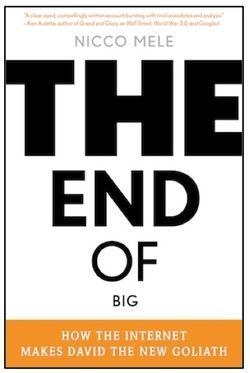 Last night I finished my advance readers' edition of The End of Big: How the Internet Makes David the New Goliath by the super-smart Nicco Mele. The book releases here in the U.S. on April 23, 2013.
Last night I finished my advance readers' edition of The End of Big: How the Internet Makes David the New Goliath by the super-smart Nicco Mele. The book releases here in the U.S. on April 23, 2013.
I enjoyed Nicco's important book very much, but not because of the frequently discussed details about how the Web allows anyone to publish and be seen. No, that's obvious. Instead what I particularly liked was his deep dive into less obvious ramifications and the cautionary aspects of the erosion of power structures.
Big is the New York Times book review. The end of big is you reading my book review on my small independent blog or on the book's Amazon page. As Nicco writes: "The end of big replaces the elite, formal, highly capitalized, institutionally backed provider of goods or services with your neighbor the poet / journalist / lawyer / soldier / designer (insert craft here)."
The book has chapters on the end of big in areas I've written about a lot including news, companies, and fun (including music and book publishing). But it also includes fascinating chapters on subjects I know little about such as the end of big government, big politics, and big armies.
Nicco certainly knows what he's talking about. As webmaster for Governor Howard Dean's 2004 presidential bid, Nicco and the campaign team popularized the use of technology and social media, revolutionizing political fundraising and reshaping American politics. Soon after, he co-founded EchoDitto, a web strategy firm whose clients included Barack Obama's successful Senate campaign. Nicco is now also on the faculty at the Harvard Kennedy School where he teaches graduate-level classes on the internet and politics.
All is not rosy
While there are many exciting aspects of the end of big in every area Nicco covers, in each there are also threats. For example, in the world of politics, radical connectivity sometimes makes backing by major parties a liability for incumbents. The rise of fringe groups such as the Tea Party and WikiLeaks are a result of the end of big because the Web rewards extremist views.
In journalism, if we no longer have big news gathering organizations, who is going to fund the big investigative story? Without the Washington Post, would Woodward and Bernstein have emerged independently? Without the Watergate Scandal how would history have differed? These are questions worth asking.
Big is not dead
What I find particularly interesting about our culture today is that big is not going away. We are all struggling to figure out which big institutions make sense in our lives today and in our future world. And we're trying to figure out which are best torn down.
For example, I note that The End of Big was not self-published. Nicco talks a lot about micro publishing but went with a big publisher (St. Martin's Press) for his own book.
But at the same time, Nicco is running EchoDitto his own small business and he also has a small publishing operation (his blog). He's someone who used small techniques (on the Web) to make both Howard Dean and Barack Obama very big.
When you are ready to dig deeper
As someone who has talked about the end of big marketing and big PR for more than a decade, I find it refreshing to read Nicco's book because it made me think about some negative aspects of our new world.
I have a tendency to be too much of a cheerleader about the rise of small and the end of big, so having this challenge to my ideas has been important to me. Thank you for that Nicco.
April 12, 2013
Newsjacking with a B2B infographic and blog post
With all the talk about the Oreo Super Bowl newsjacking juggernaut, many people think that newsjacking, the art of injecting your ideas into a breaking news story is only for consumer brands.
Joe Chernov vice president of marketing at Kinvey proves that a quick acting B2B company can have equivalent success within their target market.
Early this week, executives at Kinvey, a mobile backend as a service (BaaS) company learned that Salesforce.com was about to enter their market category. They quickly realized this would be big news.
As it turns out, not only did Salesforce.com enter the market, but Rackspace also announced a competing platform on the same day as Salesforce.com.
 Working late into the night, Joe and Kinvey CEO Sravish Sridhar crafted a blog post under Sravish's byline about the implications titled Backend as a Service Welcomes Vendor #32: Salesforce.com. They also updated their category-defining infographic Backend as a Service (BaaS) Ecosystem Map depicting all of the major players in the market.
Working late into the night, Joe and Kinvey CEO Sravish Sridhar crafted a blog post under Sravish's byline about the implications titled Backend as a Service Welcomes Vendor #32: Salesforce.com. They also updated their category-defining infographic Backend as a Service (BaaS) Ecosystem Map depicting all of the major players in the market.
The blog post went live within minutes of the Salesforce.com announcement and it triggered a bunch of discussions on Twitter, some involving journalists and analysts.
Soon after, TechCrunch, arguably the most important blog for buyers of services in the Kinvey market, wrote about Salesforce.com and Rackspace's announcements in a post titled Rackspace Rolls Out Its Mobile Plan As Vendors Get Giddy About Backend Data Pipes And Spigots.
The newsjacking success came because the bulk of the TechCrunch article talked about Sravish's post and BaaS Ecosystem Map infographic.
Newsjacking success
I connected with Joe to learn more about his newsjacking success so other B2B companies can be prepared when a similar news event happens in their marketplace.
"Newsjacking involves more than issuing a timely blog post, product placement, or press release," Joe says. "It also requires actively engaging with journalists and other influencers who are discussing the topic you wish to judo to your advantage."
When the Salesforce.com news broke, Sravish jumped into the discussions with a prominent tech journalist, industry analyst, and another CEO who were all discussing the Salesforce.com news.
"He became an active participant in the conversation, and in doing so shared his blog post," Joe says. "It was that exchange that ultimately led to the successful newsjack. My advice to others is all content - even something as time sensitive as a newsjacking post - requires a measure of hustle. It doesn't always get discovered on its own."
I love how Sravish was in real-time discussions himself. Frequently when a CEO jumps in, the credibility factor goes up and journalists pay more attention. But most CEOs are "too busy" and leave "that PR stuff" to staff.
April 10, 2013
How Raytheon implemented a brand journalism approach to content marketing
I'm always fascinated by organizations that embrace brand journalism, hiring reporters to create content that serves as marketing and public relations. For almost a decade, I've recommended that companies of all kinds model their sites not on their peers' boring old brochure-like approach but rather aspire to becoming like a media site such as Forbes, the BBC, or The New York Times and that they actually hire reporters and editors, not marketers and copywriters, to produce the content.
One look at the Raytheon homepage shows they do exactly that. There are real-time news, images, and a top stories section. And Raytheon is a B2B (and B2G) company!
"You can see our homepage is very much a news operation," says Corinne J Kovalsky, Director, Digital & Social Media at Raytheon. "We've got feature stories and trend stories about cool products."
I've engaged with Corinne for several years on social networks and recently had an opportunity to visit with her and the team at Raytheon headquarters to learn how they built the brand journalism approach to marketing and public relations.
"I'm an ex TV producer," Corinne says. "I did national news up in Canada for the CTV Network for a number of years. I produced the Canadian equivalent of Meet The Press and I have very fond memories of having journalists on staff."
In early 2011, Corinne worked with Pam Wickham, Raytheon's vice president of corporate affairs and communications to implement the brand journalism approach. Pam recognized the opportunity to establish a more robust footprint in digital and social media for the company, an idea that resonated to the very top of the organization.
Hiring brand journalists
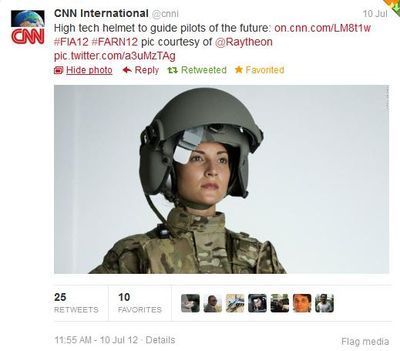 Once the plan was signed off, Corinne brought on some very impressive talent in early 2012 including Stephanie Schierholz who formerly worked as NASA social media manager. Stephanie grew the @NASA Twitter account from zero to over three million followers and helped organize some interesting "firsts" such as the first live tweet from space and the first Foursquare check-in from space.
Once the plan was signed off, Corinne brought on some very impressive talent in early 2012 including Stephanie Schierholz who formerly worked as NASA social media manager. Stephanie grew the @NASA Twitter account from zero to over three million followers and helped organize some interesting "firsts" such as the first live tweet from space and the first Foursquare check-in from space.
Stephanie now works on Raytheon social media including the @Raytheon Twitter feed. Journalists and defense department officials pay attention to the feed and frequently use the content such as this CNNi tweet of a Raytheon image of a high tech helmet to guide pilots of the future.
Soon after, Chris Hawley was hired as managing editor of digital content. Chris joined Raytheon from the Associated Press where just a few weeks earlier he won the 2012 Pulitzer Prize for Investigative Reporting for a months-long series outlining the New York Police Department's surveillance of minority and particularly Muslim neighborhoods since the 9/11 terror attacks. Now, as a brand journalist, he brings the skills he learned at AP to Raytheon.
"I'm helping to build a news operation," Chris says. "We are working at Raytheon just like an AP beat to find interesting stories and tell the world about them in a way that engages. We have bureau chiefs in all of our four divisions. They have certain products that they want to talk about so we try to find new and interesting ways of exploring those stories. And we refine the story ideas, assign writers and we're doing a lot of training on editing and getting those stories out."
Chris has also taken on the role of establishing editorial guidelines for Raytheon and teaching staff about journalism. "We've tried to codify the writing and editing process," he says. "We've come up with a checklist approach to writing a web story that goes through everything from selecting if it's going to be a hard lead story or a soft lead story, right down to which scientific study should I pay attention to when I'm evaluating background information for an article."
Content that drives the media
The content that Corinne, Chris, Stephanie, and the others on the team produce serve to educate and entertain existing and potential clients. But it also serves the media who with increasing regularity use Raytheon content to create their stories. For example, Gizmodo frequently writes about Raytheon so articles published by Raytheon such as Tiny Satellites To Give Warfighters a Bird's-Eye View of the Battlefield frequently lead to articles such as DARPA's SeeMe Satellites Are a Soldier's On-Demand Eye In the Sky on Gizmodo.
The feature packages produced by Raytheon include text and video plus photography, infographics, and animation where possible. Journalists love the video that Raytheon produces.
"We had a plant opening in Huntsville, Alabama and the factory is one of the most state of the art robotic factories in the world so we focused on the robots in the video," Corinne says. "Mark Thompson, who writes for Time, picked up the video and linked back to our feature and his headline was Elroy Jetson Is Building Missiles!"
Measuring success
While brand journalism at Raytheon has been live for less than a year, there is evidence that the approach is producing results.
"One of our big trade shows is the Association of the US Army annual conference, which happens each October," Chris says. "In the most recent one we decided to go for quality content instead of quantity. We did only three stories compared to more than 20 in 2010, but we really wrote the heck out of them. If you look at them they're really well written and capture trends. And we increased traffic 451% over the year before."
Senior management is noticing too. "Bill Swanson, Raytheon's chairman and chief executive officer, let us build this team and there are some people within the organization who, perhaps, still question why a defense company is doing social media," Corinne says. "Bill has thrown his support behind this young team and has been incredibly encouraging."
To thank the CEO, the team presented him with some Twitter cufflinks. "Well, he was so tickled that wore them during a meeting one day in front of Pam Wickham," Corinne says. "She immediately took a photo and tweeted it out. Bill's cufflinks got 17,000 impressions in 24 hours. Not everybody is that lucky to have a CEO who is so open to new developments and so willing to bring in the right talent."
Editorial note: Nice watch Mr. Swanson!
If you're an organization looking to implement a brand journalism approach to content marketing, study what Raytheon does.
Here I am with the Raytheon team at their Waltham, MA global headquarters.
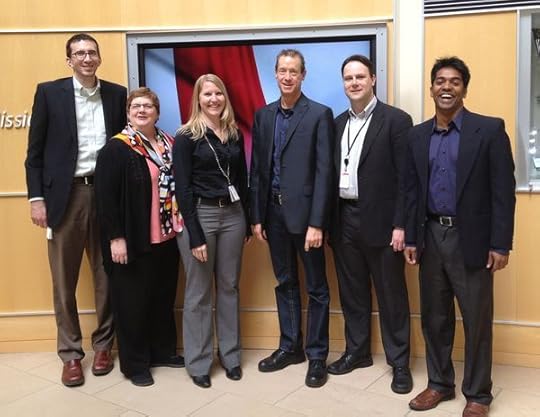
Left to Right
Doug Bonarrigo, @Bonarrdo, Digital Media Manager, is technology lead.
Corinne Kovalsky, @Kovalskyc, Director, Digital & Social Media, is the managing editor.
Stephanie Schierholz, @schierholz, Social Media Manager, is the audience advocate.
David Meerman Scott, @dmscott, that’s me and I’m lucky to have had the chance to visit Raytheon!
Chris Hawley, @chawley1, Managing Editor Digital Content, is in charge of content and programming.
Sheehan Perera, @SheehanPerera, Raytheon Leadership Development Program, is working on internal and external digital and social media.
Your chance to learn more
At Blaze, the Business Marketing Association 2013 Global Conference on May 31, I’m leading a panel "In the Moment: How and Why to Do Real-Time B2B Marketing" which includes Corinne together with Rich Jurek, Group CMO, The Inland Real Estate Group of Companies, Inc. and Matt Petitjean, Vice President, Corporate Marketing, ADP. I'm looking forward to learning more from Corinne then. If you're attending Blaze, please find me and say hello.
April 2, 2013
The journey from a traditional marketing executive to a modern CMO
 With an MBA from Wharton, a bunch of high profile marketing gigs on his resume, and a bit of gray hair to show he’s got experience, Brian Kardon is what people think of as a typical Chief Marketing Officer. He’s been there and done that. But he realized one day that everything he learned in school and from the early part of his career in the publishing business had become completely obsolete.
With an MBA from Wharton, a bunch of high profile marketing gigs on his resume, and a bit of gray hair to show he’s got experience, Brian Kardon is what people think of as a typical Chief Marketing Officer. He’s been there and done that. But he realized one day that everything he learned in school and from the early part of his career in the publishing business had become completely obsolete.
"I cared about arts and crafts," he says. "I cared about brochures and direct mail. I cared about the color on the website. And what's happened is the world had gone digital. It had gone social. It's gone mobile and we have to learn a completely new language of conversion rates and pay per click and search engine optimization and authoritative inbound links and it's a whole new world."
The journey from a traditional marketing executive to a modern CMO
I met Brian when he was CMO at Eloqua and I joined the Eloqua advisory board. Today Brian is Chief Marketing Officer at Lattice Engines a company that provides Big Data analytics for sales, marketing and business intelligence and a platform provider for predictive analytics.
There was a moment that caused Brian to realize he was turning into a marketing dinosaur and heading toward extinction. "Within my second month at being at Eloqua, I read a book called Inbound Marketing by Brian Halligan and Dharmesh Shah and I didn't put it down," Brian says. "I read it in 2.5 hours and I said to myself 'I have to give this book to everyone in my team because the world of outbound marketing is being disrupted. Everyone is time shifting. You can pause and you don't have to watch commercials. Spam filters are out there. Messages aren't going through."
[Disclosure: I wrote the foreword to Inbound Marketing.]
Brian realized that there was a new way to do marketing and the tools and techniques that were described in the book were things he didn't understand and he realized he needed to learn.
"I didn't really understand what meta tags, alt tags, and title tags were." He says. "I didn't understand about blog platforms and how WordPress worked. I didn't understand about pay per click. I didn't understand all of these things. I was the CMO. Could I have just skated along and had all my team members understand those things? I think I could have, but you can't outrun the ball. For a certain amount of time you can, but you'll get to a point where someone asks a technical question or something with a little more depth and if you haven't done it, you're not going to be successful."
Brian then did something that many executives are unwilling to do. He asked his team for help. Often. He freely admitted his ignorance but also showed he was willing to learn. And he proved he was willing to jump in and actually do real work rather than just direct from the sidelines.
"I decided just to roll up my sleeves and ask people on my team, 'How did you do that?' I had a bunch of people in their 20s and I would just sit next to them and say, 'Tell me how you did that. How did you push that out there?' or 'What are those social sharing links? How did you put that on there?' I asked how HTML works and what Java script is.”
Today, Brian's 11,000+ followers of his @bkardon Twitter feed show that he's in the thick of the action and making it happen. And his work at Lattice Engines wouldn't be possible without his willingness to get down into the weeds to understand data and the technologies of digital communications.
"Lattice Engines is all about using patterns and predictive analytics to help sales people identify those prospects most likely to buy now," he says of the services that Lattice Engines offers. "Marketers are sitting on mountains of data on purchase histories. What did David Meerman Scott buy? When did he buy it? Did he pay full price? Did he buy the scarf? Was it a gift? Was it for himself? We found there's a new breed of company that is using past to predict future. You can find patterns that actually predict that David Meerman Scott's going to buy a purple scarf next month or that you only buy running shoes in November."
I asked Brian to offer advice to other senior marketers making the transition: "You've got to tell yourself you're a child again and you have to relearn what you’re doing."
March 28, 2013
Do not delete your content because it should live forever
 As I was working on a writing project this week, I went o back to take a look at a YouTube video that I talked about on my blog in an August 2010 post titled Awesome Air New Zealand All Blacks rugby safety video. I've mentioned the Air New Zealand - Crazy About Rugby - Safety Video in one of my books and in talks around the world. Remarkably, this had been an airline safety video (you know, how to buckle your seatbelt) with over one million YouTube views!
As I was working on a writing project this week, I went o back to take a look at a YouTube video that I talked about on my blog in an August 2010 post titled Awesome Air New Zealand All Blacks rugby safety video. I've mentioned the Air New Zealand - Crazy About Rugby - Safety Video in one of my books and in talks around the world. Remarkably, this had been an airline safety video (you know, how to buckle your seatbelt) with over one million YouTube views!
Even more remarkably, it seems Air New Zealand has removed the video because it is now marked as private. What a lost opportunity for Air New Zealand.
Do not delete your content
Much of your web content should live forever. This video would have continued to rack up views, make people laugh, and serve to humanize Air New Zealand forever. But now it is gone. In reviewing the Air New Zealand YouTube channel, which was created on May 31, 2006 and has 24 million total views, it seems that all videos older than 3 years have been removed. Why in the world would they do that?
I frequently witness this silliness with conference organizers who have one URL for their annual conference and each year delete the prior year's content and replace it with new. Don't do this!
The media in your industry, speakers, bloggers, and exhibiters all link to the conference site and if the content is deleted as soon as the conference ends those links break.
A well-organized conference site is an important historical artifact that provides valuable information many years later. Who spoke that year? What panel discussions were held? What companies sponsored the event? People want to know that your conference has thrived for over a decade. Rather than use one conferenceURL why not make it conferenceURL/2013 and then next year make it conferenceURL/2014? The homepage can then point to the current year's conference.
The SEO benefit of many links
Your Search Engine Marketing benefits from multiple pages with many inbound links. Cultivate your content with care and it will serve as a marketing asset for years to come.



